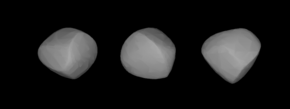Main-belt asteroid
160 Una is a fairly large and dark, primitive Main belt asteroid that was discovered by German-American astronomer C. H. F. Peters on February 20, 1876, in Clinton, New York .[ 8] Edmund Spenser 's epic poem The Faerie Queene Sun at a distance of AU eccentricity of 0.07. The orbital plane is inclined at an angle of 3.83° to the plane of the ecliptic .[ 2]
In the Tholen classification system it is categorized as a CX-type , while the Bus asteroid taxonomy system lists it as an Xk asteroid .[ 9] Photometric observations of this asteroid made at the Torino Observatory in Italy during 1990–1991 were used to determine a synodic rotation period of 5.61 ± 0.01 hours.[ 3]
References
^ Benjamin Smith (1903) The Century Dictionary and Cyclopedia
^ a b c d e Yeomans, Donald K., "160 Una" , JPL Small-Body Database Browser , NASA Jet Propulsion Laboratory , retrieved 12 May 2016 . ^ a b di Martino, M.; et al. (February 1994), "Lightcurves and rotational periods of nine main belt asteroids", Icarus , 107 (2): 269– 275, Bibcode :1994Icar..107..269D , doi :10.1006/icar.1994.1022 . ^ "Lightcurves and map data on numbered asteroids N° 1 to 52225" . Archived from the original on 27 November 2005. Retrieved 3 November 2008 .^ "Infrared Astronomical Satellite (IRAS)" . Archived from the original on 24 February 2005. Retrieved 24 February 2005 .^ Asteroid Lightcurve Data File, Updated March 1, 2001 ^ Warner, Brian D. (December 2007), "Initial Results of a Dedicated H-G Project", The Minor Planet Bulletin , 34 (4): 113– 119, Bibcode :2007MPBu...34..113W . ^ "Numbered Minor Planets 1–5000" , Discovery Circumstances , IAU Minor Planet center, retrieved 7 April 2013 .^ DeMeo, Francesca E.; et al. (July 2009), "An extension of the Bus asteroid taxonomy into the near-infrared" (PDF) , Icarus , 202 (1): 160– 180, Bibcode :2009Icar..202..160D , doi :10.1016/j.icarus.2009.02.005 , archived from the original (PDF) on 17 March 2014, retrieved 8 April 2013 .
External links
